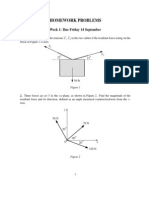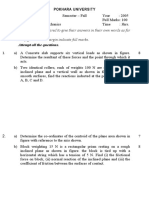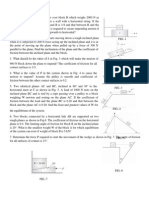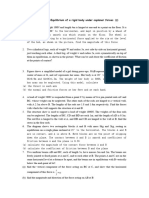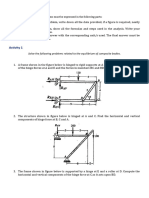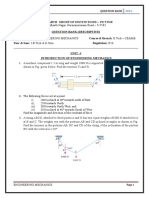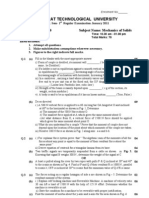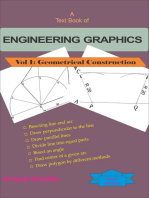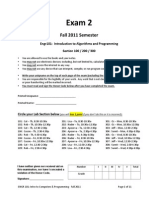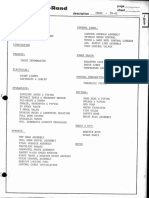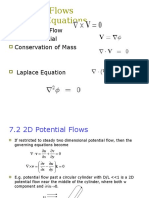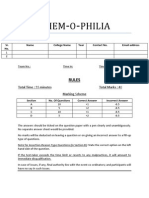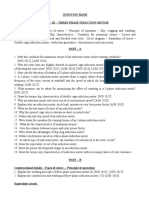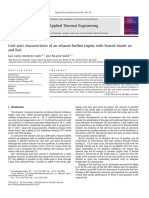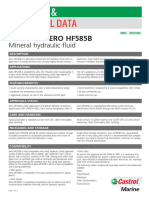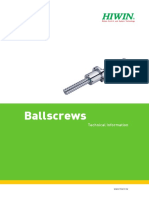Homework Problems: Week 2: Due Friday 21 September
Homework Problems: Week 2: Due Friday 21 September
Uploaded by
Krishna MahajanCopyright:
Available Formats
Homework Problems: Week 2: Due Friday 21 September
Homework Problems: Week 2: Due Friday 21 September
Uploaded by
Krishna MahajanOriginal Description:
Original Title
Copyright
Available Formats
Share this document
Did you find this document useful?
Is this content inappropriate?
Copyright:
Available Formats
Homework Problems: Week 2: Due Friday 21 September
Homework Problems: Week 2: Due Friday 21 September
Uploaded by
Krishna MahajanCopyright:
Available Formats
HOMEWORK PROBLEMS
Week 2: Due Friday 21 September
1. Figure 1 shows a right-angle crowbar ABC which makes frictionless contact with a rigid wall at the points A, D and E . Find the reaction forces at these contact points when the crowbar is loaded by a 200 N vertical force at C as shown.
A 120
D 30 E 500 C
o
170
200 N
all dimensions in mm Figure 1
2. Three identical homogeneous (i.e. spatially uniform) rectangular blocks, each of weight W and length a are stacked one on top of the other, as shown in Figure 2. Determine the maximum distance d that the upper block can extend beyond the edge of the lowest one if the stack is not to topple over. For extra credit, answer this question if there are N blocks, where N is any integer. Is there a limit to d if we have an unlimted number of blocks?
a
Figure 2
3. In Figure 3, The uniform rod AB is of weight W and length L and the end B is attached by a weightless rope BC to the wall at C . The roller at A slides in a vertical groove and that at B on a horizontal plane. There is no friction at either A or B . Draw a free-body diagram of the body AB and hence determine the tension in the rope.
30 o B 30 o
Figure 3 2
4. Figure 4 shows a uniform rectangular plate ABCD of weight 2 kN that is supported in a horizontal position by hinges at A, D and a rope CE . Find the reactions at the hinges and the tension in the rope. Assume that only the hinge at A can support thrust.
y 3 E A 3 6 B D z 4 C
all dimensions in meters Figure 4
5. Figure 5 shows a thin uniform rod OA of length 2 m and weight 40 N that rests against the intersection of three walls at O and is supported by two cables AB and AC attached to the walls at B (0, 2.5, 1.5) and C (1, 2.5, 0), where the coordinates are in meters. Find the coordinates of A if the cables are each of length 2 meters and hence nd the tensions in the cables.
y C
Figure 5
6. Figure 6 shows a uniform door of weight 300 N supported on two hinges A, B . Only the lower hinge B carries thrust. Due to an error during installation, hinge A is located 5 mm to the right of the correct position which would be vertically above B . If each hinge opposes rotation by a frictional moment of 0.15 Nm, is this sufcient to ensure that the door will remain in the position illustrated with the door perpendicular to the wall?
1.9 2.3 B 0.2 1.0
all dimensions in meters Figure 6
7. Figure 7 shows a ladder of length L, whose weight W acts at the mid-point. The coefcient of friction between the ladder and the oor and between the ladder and the wall is = 0.3. (i) Find the minimum value of the angle if the ladder is to be in equilibrium in the conguration shown. (ii) A man of weight 10W sets the ladder against the wall at an angle given by tan() = 1.1 tan(c ) , where c is the minimum angle that you found in part (i). He now starts to climb the ladder carefully. Will he be able to get to the top of the ladder safely and if not, how far up the ladder will he be when it slips?
Figure 7
8. Figure 8 shows a device for storing tools such as brushes and brooms. It comprises two cylindrical rollers which roll against two surfaces inclined at an angle to the vertical as shown. If the coefcient of friction at all contact surfaces is 0.2, what is the maximum angle that will enable the device to function as a support.
Figure 8
You might also like
- CA 2 MomentsDocument3 pagesCA 2 MomentsOctavius_19930% (5)
- Porter Easter Ling SolutionsDocument74 pagesPorter Easter Ling SolutionsKrishna Mahajan60% (10)
- ME211.F2014.PbSet2 (1) - 2Document8 pagesME211.F2014.PbSet2 (1) - 2Khan ABNo ratings yet
- Question Bank Engg. MechanicsDocument18 pagesQuestion Bank Engg. MechanicsSakendra Kumar0% (2)
- Pages4 41 To 52 PDFDocument12 pagesPages4 41 To 52 PDFIsmael de PabloNo ratings yet
- Equilibrium Statics ProblemsDocument10 pagesEquilibrium Statics ProblemsTheAznNo ratings yet
- Flywheel ExperimentDocument7 pagesFlywheel ExperimentNabil IbrahimNo ratings yet
- School of Mechanical Engineering, Kiit University Assignment 1 Subject: Engineering Mechanics DueonDocument3 pagesSchool of Mechanical Engineering, Kiit University Assignment 1 Subject: Engineering Mechanics Dueonmantra20100% (3)
- ASSIGNMENT 1 Essentials of Mechanical EngineeringDocument2 pagesASSIGNMENT 1 Essentials of Mechanical EngineeringHari OmNo ratings yet
- Plate 5Document8 pagesPlate 5s.manreza.525419No ratings yet
- Be Excel For Physics 1Document7 pagesBe Excel For Physics 1naniey1981No ratings yet
- Homework Problems: Week 1: Due Friday 14 SeptemberDocument5 pagesHomework Problems: Week 1: Due Friday 14 SeptemberKrishna MahajanNo ratings yet
- Ce 336Document7 pagesCe 336reynanbelendhran23No ratings yet
- Assignment 1 MOSDocument47 pagesAssignment 1 MOSGaurav RajNo ratings yet
- PH 110 Tutorial - 4 - Dynamics - 2024Document7 pagesPH 110 Tutorial - 4 - Dynamics - 2024rachaelkalima11No ratings yet
- Mechanics LongDocument5 pagesMechanics Longsivaraju8No ratings yet
- Part B Question BankDocument9 pagesPart B Question BankSriram SrinivasanNo ratings yet
- Tutorial/Homework 1Document7 pagesTutorial/Homework 1Lily MaronNo ratings yet
- Buddha Institute of TechnologyDocument3 pagesBuddha Institute of Technologylatendra kumar srivastavNo ratings yet
- Assisgnment 2Document5 pagesAssisgnment 2atharvnetke9No ratings yet
- Tutorial 2Document2 pagesTutorial 2Samyak SinghNo ratings yet
- Candidates Are Required To Give Their Answers in Their Own Words As Far As Practicable. The Figures in The Margin Indicate Full MarksDocument4 pagesCandidates Are Required To Give Their Answers in Their Own Words As Far As Practicable. The Figures in The Margin Indicate Full MarksManish Shrestha100% (1)
- 25 Moments&EqmDocument4 pages25 Moments&Eqmanesthesia24desuNo ratings yet
- ENGINEERING MECHANICS Assignment WorkDocument14 pagesENGINEERING MECHANICS Assignment WorkAchyut MorangNo ratings yet
- Sheet No.5Document2 pagesSheet No.5Mohamed MaherNo ratings yet
- Ejercicios 3DDocument6 pagesEjercicios 3DDaniel Joya BeltranNo ratings yet
- Assignment 1Document5 pagesAssignment 1Mansimran Singh-iit GuwahatiNo ratings yet
- Categories of Equilibrium: Problem 1.1Document33 pagesCategories of Equilibrium: Problem 1.1Suresh NatarajanNo ratings yet
- Equilibrium Lamis Theorem and CylindersDocument10 pagesEquilibrium Lamis Theorem and Cylinders241154No ratings yet
- Assignment # 4 MomentsDocument9 pagesAssignment # 4 MomentsKalidNo ratings yet
- Moments Integral TestDocument3 pagesMoments Integral TestMalika Chandoo100% (1)
- Rigid Body 3DDocument6 pagesRigid Body 3DSyed ShaulNo ratings yet
- Jointed Rods and Frame WorksDocument3 pagesJointed Rods and Frame WorksJanaka Priyalal100% (1)
- Em AssignmentDocument3 pagesEm AssignmentAnonymous 3VNugn100% (1)
- ObjectiveDocument2 pagesObjectivedrjbjp0% (1)
- A2讲义习题 (45) -Equilibrium of a rigid body under coplanar forcesDocument1 pageA2讲义习题 (45) -Equilibrium of a rigid body under coplanar forcesyanghaoyi1985No ratings yet
- NLM PDFDocument4 pagesNLM PDFsajal prustyNo ratings yet
- Plate 5 Cee117Document6 pagesPlate 5 Cee117Louie Jey NisnisanNo ratings yet
- Question BankDocument9 pagesQuestion Bankpragash100% (1)
- Physics I Problems PDFDocument1 pagePhysics I Problems PDFBOSS BOSSNo ratings yet
- Tutorial 3Document5 pagesTutorial 3TinkuDhullNo ratings yet
- Tutorial 4Document4 pagesTutorial 4Rajkamal NayakNo ratings yet
- Lami TheoremDocument3 pagesLami Theoremmartini016No ratings yet
- Question Bank & Bit BankDocument20 pagesQuestion Bank & Bit BankKomma HemaNo ratings yet
- Part A (5 X 2 10) (Answer All The Questions)Document2 pagesPart A (5 X 2 10) (Answer All The Questions)RajueswarNo ratings yet
- 3b-Torque FR Practice ProblemsDocument4 pages3b-Torque FR Practice ProblemsSnowy JiangNo ratings yet
- Assignment 7 emDocument2 pagesAssignment 7 emoperationmanagerNo ratings yet
- Ass 3 An Rem EMDocument4 pagesAss 3 An Rem EMAbhay Singh ChauhanNo ratings yet
- Frame Works PDFDocument2 pagesFrame Works PDFJanaka Priyalal100% (1)
- Second Semester Examination, 2002-2003: B. TechDocument7 pagesSecond Semester Examination, 2002-2003: B. Techlatendra kumar srivastavNo ratings yet
- Ge8292 Rejinpaul Iq April May 2019 PDFDocument8 pagesGe8292 Rejinpaul Iq April May 2019 PDFThamizh gomathiNo ratings yet
- Module1 - Set 1bDocument5 pagesModule1 - Set 1bindhubalab200413chNo ratings yet
- Homework Problems: Week 3: Due Friday 28 SeptemberDocument6 pagesHomework Problems: Week 3: Due Friday 28 SeptemberKrishna MahajanNo ratings yet
- EquilibriumDocument6 pagesEquilibriumChristopher MorrisNo ratings yet
- Me601 HW1Document6 pagesMe601 HW1chinmayNo ratings yet
- 12 MarksDocument23 pages12 Markslakshmigsr6610No ratings yet
- Buckling TutorialsDocument10 pagesBuckling TutorialsNkanyiso MsweliNo ratings yet
- 1111-110010-Mech - of SolidsDocument4 pages1111-110010-Mech - of SolidsjaydeepNo ratings yet
- Practical Stair Building and Handrailing: By the square section and falling line systemFrom EverandPractical Stair Building and Handrailing: By the square section and falling line systemNo ratings yet
- Exam 2: Fall 2011 SemesterDocument11 pagesExam 2: Fall 2011 SemesterKrishna MahajanNo ratings yet
- Homework Problems: Week 3: Due Friday 28 SeptemberDocument6 pagesHomework Problems: Week 3: Due Friday 28 SeptemberKrishna MahajanNo ratings yet
- Homework Problems: Week 1: Due Friday 14 SeptemberDocument5 pagesHomework Problems: Week 1: Due Friday 14 SeptemberKrishna MahajanNo ratings yet
- MP 6Document12 pagesMP 6Krishna MahajanNo ratings yet
- p240f12 Midterm 3-SolutionsDocument13 pagesp240f12 Midterm 3-SolutionsKrishna MahajanNo ratings yet
- IR TH-60 ManualDocument475 pagesIR TH-60 ManualwalkercadillacNo ratings yet
- Final Report On Electric Car Jack 3 PDFDocument30 pagesFinal Report On Electric Car Jack 3 PDFify100% (2)
- Sever Makina Parts ListDocument155 pagesSever Makina Parts ListAnonymous srN69mFENo ratings yet
- Windload ComputationsDocument9 pagesWindload Computationsapi-264559415No ratings yet
- Boiler FormulasDocument4 pagesBoiler Formulasjoabjim8392100% (1)
- Hydraulic Calculation Report R0Document36 pagesHydraulic Calculation Report R0Pawan Sparrow100% (1)
- Job 2251 Pama 290 Manual Unit 039Document201 pagesJob 2251 Pama 290 Manual Unit 039Pramudya Izza arystaNo ratings yet
- Theory - C6.1 Thin-Walled Pressure Vessels - Solid Mechanics IDocument3 pagesTheory - C6.1 Thin-Walled Pressure Vessels - Solid Mechanics IbahmanNo ratings yet
- Lecture - 3-The Second Law of Thermodynamics and EntropyDocument16 pagesLecture - 3-The Second Law of Thermodynamics and EntropyahmedNo ratings yet
- Potential Flows Integral Equations: Irrotational Flow Flow Potential Conservation of MassDocument52 pagesPotential Flows Integral Equations: Irrotational Flow Flow Potential Conservation of MassAhsan AliNo ratings yet
- Quote For PRV NittechDocument1 pageQuote For PRV Nittechmiddle lastNo ratings yet
- F I R E W A L L: MB Holding Company, Inc As-Built Tube Ice Plant Oswald B. PuzonDocument1 pageF I R E W A L L: MB Holding Company, Inc As-Built Tube Ice Plant Oswald B. PuzonJan GarciaNo ratings yet
- The Response of Large Pressure Vessels in The Process Industries To Excess Pressure: Literature ReviewDocument52 pagesThe Response of Large Pressure Vessels in The Process Industries To Excess Pressure: Literature ReviewNoel Federer SarkarNo ratings yet
- CATALOGO Gea T Smart Butterfly Valves Catalog Tcm38 13853Document94 pagesCATALOGO Gea T Smart Butterfly Valves Catalog Tcm38 13853Matheus Vinicius SilvaNo ratings yet
- NAR Lift-Drag Wake TurbulenceDocument28 pagesNAR Lift-Drag Wake TurbulenceDawit LemmaNo ratings yet
- Chem o Phila ElimsDocument8 pagesChem o Phila ElimsRaghav AgrawalNo ratings yet
- Structural Design CAlculationsDocument12 pagesStructural Design CAlculationsnimish.aquamarineNo ratings yet
- Planetry GearsDocument10 pagesPlanetry Gearsvinu1175No ratings yet
- Em II Question BankDocument5 pagesEm II Question BankSaradha DeviNo ratings yet
- CPCB II-oil-fuel-coolant CapacityDocument1 pageCPCB II-oil-fuel-coolant CapacityAnil KumarNo ratings yet
- HdpeeDocument38 pagesHdpeeSamet BelliNo ratings yet
- Hydraulic System (First Used On 1529, 1533 Up To 1562, 1564, 1565 and 1569)Document36 pagesHydraulic System (First Used On 1529, 1533 Up To 1562, 1564, 1565 and 1569)stefan corjuc100% (2)
- Applied Thermal Engineering: Luis Carlos Monteiro Sales, José Ricardo SodréDocument4 pagesApplied Thermal Engineering: Luis Carlos Monteiro Sales, José Ricardo SodréAnaNo ratings yet
- Aero HF585BDocument2 pagesAero HF585BcarmaNo ratings yet
- Topic 7. PressureDocument16 pagesTopic 7. PressureFahadNo ratings yet
- Ballscrew CatalogoDocument193 pagesBallscrew CatalogoAlejandro Sandoval TrianaNo ratings yet
- MAN FFR Fault Codes List PDFDocument13 pagesMAN FFR Fault Codes List PDFДмитрий Андрущенко100% (1)
- Machine Foundation Design PDFDocument44 pagesMachine Foundation Design PDFAnonymous WeDXoM1QNo ratings yet
- HydraulicDocument4 pagesHydraulicpranabNo ratings yet











